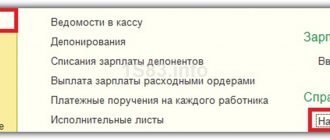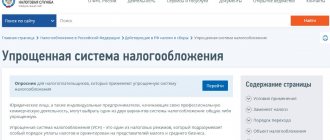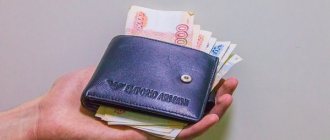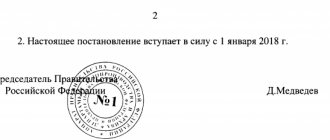The right of “simplers” to reduced insurance premium rates
Organizations and individual entrepreneurs using the simplified tax system can apply reduced tariffs if they are engaged in certain types of activities. To do this, two basic conditions must be met:
- income from this type of activity constitutes at least 70 percent of the total amount of all receipts for the reporting period (that is, from the beginning of the year);
- the total amount of income does not exceed 79,000,000 rubles.
This is stated in subparagraph 5 of paragraph 1, subparagraph 3 of paragraph 2, paragraphs 3 and 6 of Article 427 of the Tax Code of the Russian Federation.
Preferential tariffs when combining simplified taxation system and UTII
The combination of two special regimes - simplified tax system and UTII - is permitted by tax legislation. If a “simpler” who has the right to a preferential rate of insurance premiums is still carrying out activities transferred to UTII, he will not lose the right to the benefit if the share of income from the main activity is 70% or more of the total income.
For example, a company combines the simplified tax system and UTII. Moreover, the main type of activity from which it receives more than 70% of its income is imputation. If this type of business is listed in the list of preferential types of activities (clause 5, clause 1, Article 427 of the Tax Code of the Russian Federation), then the “simplified” person can pay insurance premiums at a reduced rate in relation to the “imputed” activity.
However, in this case, the second criterion - based on the total amount of income for the year, which should not exceed 79 million rubles - is determined for all types of activities (both simplified taxation system activities and “imputation”).
The situation is different if a company or individual entrepreneur applies only UTII in relation to a preferential type of activity. In this case, she cannot count on benefits in the form of reduced insurance premium rates (letter of the Ministry of Finance of Russia dated April 3, 2021 No. 03-15-06/19230). This is due to the fact that there are no provisions in the Tax Code that would establish reduced insurance premium rates only for “imputed” people. Therefore, organizations and individual entrepreneurs on UTII, engaged, for example, in the maintenance and repair of cars, cannot apply reduced insurance premium rates.
Since 2021, new OKVED will be in force
On January 1, 2021, Rosstandart introduced OKVED2 instead of OKVED1. However, despite the transitional keys, not all old activity codes coincided with the new ones. Because of this, starting from 2021, not all organizations could apply reduced insurance premium rates.
The Russian Ministry of Finance, in letter No. 03-15-07/66964 of the Russian Ministry of Finance dated October 13, 2017, allowed the continued application of reduced tariffs to those who enjoyed the benefit until 2021. Even the types of activities OKVED1 and OKVED2 do not coincide. However, this state of affairs was rather strange. After all, benefits must be applied on the basis of regulatory legal acts, and not with the permission of officials.
Income share clause
The condition of a 70% share of income from core activities established by clause 6 of Art. 427 of the Tax Code of the Russian Federation, must be carried out throughout the entire period of application by the “simplified” reduced tariffs of insurance premiums.
In other words, if at the end of the 2021 calculation year the condition of a 70% share of income from core activities is met, then from 2018 the “simplified” has the right to apply reduced tariffs. However, if, based on the results of activities for the reporting (billing) period, he does not confirm compliance with the specified condition, then he will lose the right to reduced tariffs, and retroactively - from the beginning of the billing (reporting) period in which the discrepancy was made. The Federal Tax Service drew attention to this nuance in Letter dated March 1, 2017 N BS-4-11/3705.
From paragraph 6 of Art. 427 of the Tax Code of the Russian Federation it follows that a similar mechanism operates in the opposite direction, since income under the simplified tax system is determined on an accrual basis. That is, in practice, situations are possible when, for example, at the end of the first half of 2021, the condition of a 70% share of income from the main activity will be met. In this case, the simplifier will have the right to recalculate insurance premiums, applying reduced rates from the beginning of the billing period.
The legality of such a recalculation was noted by Federal Tax Service specialists in Letter dated October 25, 2017 N ГД-4-11/ [email protected] They explained that in order to exercise the right to retroactively reduced tariffs, the “simplified” person must fill out Appendix 6 “Calculation of compliance with the conditions for applying the reduced tariff of insurance contributions by payers specified in subparagraph 5 of paragraph 1 of Article 427 of the Tax Code of the Russian Federation" to Sec. 1 calculation (Calculation form approved by Order of the Federal Tax Service of Russia dated 10.10.2016 N ММВ-7-11/ [email protected] ), and in accordance with Art. 81 of the Tax Code of the Russian Federation - provide updated calculations for past reporting periods (in particular, for the first quarter of 2018).
Let us add: the “simplified” person can subsequently dispose of the amount of overpayment for insurance premiums at his own discretion: either return it or count it against future payments (clause 1.1 of Article 78 of the Tax Code of the Russian Federation).
What has changed since November 27, 2017
On November 27, 2021, Federal Law No. 335-FZ dated November 27, 2017 came into force. In this regard, the names of preferential types of activities now coincide with the names of the structural units of OKVED 2. And now there is no need to use transition keys between the classifiers OKVED1 and OKVED2.
The new list of preferential types of activities eliminates the problem of discrepancies between individual codes according to OKVED 1 and OKVED 2. Thus, in particular, previously it was unclear whether organizations and individual entrepreneurs could apply reduced tariffs for the following types of activities:
- activities of travel agencies and tour operators;
- computer equipment management;
- repair of machinery and equipment, repair of electrical equipment.
These types of activities are included in the new list. This means you can definitely apply the benefit!
The new edition of the amendments applies to the period starting from January 1, 2021. Therefore, if an organization transferred insurance premiums at the usual rate during 2021, then it should submit updated calculations of contributions to the Federal Tax Service, as well as applications for offset (refund) of overpaid payments.
Basic insurance premium rates in 2021
Insurance premiums at the basic rates are paid by those employers (customers under GPC agreements) who are not entitled to preferential rates in accordance with Article 427 of the Tax Code of the Russian Federation. The total rate for them in 2018 will be 30% (Article 426 of the Tax Code of the Russian Federation), of which:
- 22% – accounted for by pension insurance;
- 5.1% – falls on health insurance;
- 2.9%* – accounts for social insurance.
<*> The percentage of calculation of social insurance contributions from payments to foreigners and stateless persons who are temporarily staying in the Russian Federation and are not highly qualified specialists is 1.8% (paragraph 2, paragraph 2, article 426 of the Tax Code of the Russian Federation).
By the way! The authorities have maintained a 30 percent rate on contributions until 2021 (inclusive). Let us recall that previously the Tax Code stipulated a different expiration date for this tariff – 2021.
At the same time, contributions to OPS and OSS in case of VNIM are calculated according to the tariffs indicated above until the total amount of payments in favor of an individual from the beginning of the year (taxable base) reaches the maximum value.
The maximum amount of the base for each type of contribution is different. It is established annually by the Government of the Russian Federation (clauses 3 – 6 of Article 421 of the Tax Code of the Russian Federation). Thus, the following values are planned for 2021:
- the maximum base for contributions to compulsory pension insurance is 1,021,000 rubles;
- the maximum base for contributions to OSS in the case of VNiM is 815,000 rubles.
You can find out more information about the maximum base for calculating insurance premiums in 2021 from this article.
When the maximum value is reached, the income of a “physicist” (paragraph 3, clause 1, article 426 of the Tax Code of the Russian Federation, clause 3, article 421 of the Tax Code of the Russian Federation):
- subject to compulsory health insurance contributions at a rate of 10%;
- is not subject to contributions to OSS in case of VniM.
Note! There is no maximum base for medical contributions, so they are calculated from all taxable payments of a citizen.
Table 1 – Basic rates of insurance premiums in 2021
| Contribution tariff for compulsory pension insurance | Contribution tariff for compulsory medical insurance | Tariff of contributions to OSS in case of VNiM | ||
| from payments not exceeding RUB 1,021,000 in total since the beginning of the year. | from payments exceeding RUB 1,021,000 in total since the beginning of the year. | from payments not exceeding RUB 815,000 in total since the beginning of the year. | from payments exceeding RUB 815,000 in total since the beginning of the year. | |
| 22% | 10% | 5,1% | 2,9% | — |
New list and new codes
Let's assume that the company's type of activity code begins with the numbers from the left column of the new list of preferential types of activities according to the simplified tax system. If so, you can pay insurance premiums at reduced rates, which means you can apply a reduced rate (subject to other requirements). Here is a table with the new OKVED2, valid from November 27, 2017:
| OKVED code 2 | Name of the grouping of activities from the list given in the Tax Code |
| 10 | Food production |
| 11.07 | Production of soft drinks, production of mineral waters and other bottled drinking waters |
| 13 | Textile production |
| 14 | Manufacture of wearing apparel |
| 15 | Production of leather and leather products |
| 16 | Wood processing and production of wood and cork products, except furniture, production of straw products and wicker materials |
| 17 | Production of paper and paper products |
| 20 | Production of chemicals and chemical products |
| 21 | Production of medicines and materials used for medical purposes |
| 22 | Production of rubber and plastic products |
| 23 | Production of other non-metallic mineral products |
| 24.33 | Production of profiles using cold stamping or bending |
| 24.34 | Wire production using cold drawing method |
| 25 | Production of finished metal products, except machinery and equipment |
| 26 | Production of computers, electronic and optical products |
| 27 | Electrical Equipment Manufacturing |
| 28 | Production of machinery and equipment not included in other categories |
| 29 | Production of motor vehicles, trailers and semi-trailers |
| 30 | Manufacture of other vehicles and equipment |
| 31 | Furniture manufacture |
| 32.2 | Production of musical instruments |
| 32.3 | Production of sporting goods |
| 32.4 | Production of games and toys |
| 32.5 | Production of medical instruments and equipment |
| 32.9 | Production of products not included in other groups |
| 33 | Repair and installation of machinery and equipment |
| 37 | Wastewater collection and treatment |
| 38 | Collection, processing and disposal of waste, processing of secondary raw materials |
| 41 | Building |
| 42 | Construction of engineering structures |
| 43 | Specialized construction works |
| 45.2 | Vehicle maintenance and repair |
| 47.73 | Retail trade of medicines in specialized stores (pharmacies) |
| 47.74 | Retail trade of products used for medical purposes, orthopedic products in specialized stores |
| 49 | Activities of land and pipeline transport |
| 50 | Water transport activities |
| 51 | Air and space transport activities |
| 52 | Warehousing and auxiliary transport activities |
| 53 | Postal and courier activities |
| 59.1 | Production of films, videos and television programs |
| 60 | Activities in the field of television and radio broadcasting |
| 61 | Activities in the field of telecommunications |
| 62 | Computer software development, consulting services in the field and other related services |
| 63 | Activities in the field of information technology |
| 68.32 | Real estate management on a fee or contract basis |
| 72 | Research and development |
| 75 | Veterinary activities |
| 79 | Activities of travel agencies and other organizations providing services in the field of tourism |
| 81 | Maintenance activities for buildings and grounds |
| 85 | Education |
| 86 | Health activities |
| 87 | Residential care activities |
| 88 | Providing social services without providing accommodation |
| 90.04 | Activities of cultural and art institutions |
| 91 | Activities of libraries, archives, museums and other cultural facilities |
| 93.11 | Activities of sports facilities |
| 93.12 | Activities of sports clubs |
| 93.13 | Activities of fitness centers |
| 93.19 | Other activities in the field of sports |
| 95 | Repair of computers, personal and household items |
| 96 | Activities providing other personal services |
Read also
26.01.2018
List of activities
So that you do not have to wade through the jungle of the law, which has more than 100 pages, and study the entire Talmud on your own, we have prepared for you a convenient table with a list of activities for applying reduced contributions.
| Activities | |
| Was | It became |
| food production | food production |
| production of mineral waters and other non-alcoholic drinks | production of soft drinks, production of mineral waters and other bottled drinking waters |
| textile and clothing production | textile production |
| manufacture of wearing apparel | |
| production of leather, leather goods and footwear production | production of leather and leather products |
| wood processing and production of wood products | wood processing and production of wood and cork products, except furniture, production of straw products and wicker materials |
| chemical production | production of chemicals and chemical products |
| production of medicines and materials used for medical purposes | |
| production of rubber and plastic products | production of rubber and plastic products |
| production of other non-metallic mineral products | production of other non-metallic mineral products |
| production of finished metal products | production of finished metal products, except machinery and equipment |
| production of machinery and equipment | production of machinery and equipment not included in other categories |
| production of electrical equipment, electronic and optical equipment | production of computers, electronic and optical products |
| production of electrical equipment | |
| production of vehicles and equipment | production of motor vehicles, trailers and semi-trailers |
| production of other vehicles and equipment | |
| furniture manufacture | furniture manufacture |
| production of sporting goods | production of sporting goods |
| production of games and toys | production of games and toys |
| research and development | research and development |
| education | education |
| health and social services | health activities |
| residential care activities | |
| provision of social services without providing accommodation | |
| activities of sports facilities | activities of sports facilities |
| other activities in the field of sports | activities of sports clubs |
| activities of fitness centers | |
| other sports activities | |
| processing of secondary raw materials | collection, processing and disposal of waste; processing of secondary raw materials |
| construction | building |
| construction of engineering structures | |
| specialized construction work | |
| vehicle maintenance and repair | vehicle maintenance and repair |
| disposal of sewage, waste and similar activities | wastewater collection and treatment |
| transport and communications | activities of land and pipeline transport |
| water transport activities | |
| air and space transport activities | |
| warehousing and auxiliary transport activities | |
| postal and courier activities | |
| activities in the field of television and radio broadcasting | |
| activities in the field of telecommunications | |
| provision of personal services | activities related to the provision of other personal services |
| production of cellulose, wood pulp, paper, cardboard and products made from them | production of paper and paper products |
| production of musical instruments | production of musical instruments |
| production of various products not included in other groups | production of products not included in other groups |
| repair of household products and personal items | repair of computers, personal and household items |
| real estate management | management of real estate for a fee or on a contract basis |
| activities related to the production, distribution and screening of films | production of films, videos and television programs |
| activities of museums and protection of historical sites and buildings | activities of cultural and art institutions |
| activities of libraries, archives, club-type institutions (except for the activities of clubs) | activities of libraries, archives, museums and other cultural objects |
| activities of botanical gardens, zoos and nature reserves | |
| activities related to the use of computer technology and information technology, with the exception of organizations and individual entrepreneurs specified in subparagraphs 2 and 3 of paragraph 1 of Article 427 of the Tax Code | activities in the field of information technology, with the exception of organizations and individual entrepreneurs specified in subparagraphs 2 and 3 of paragraph 1 of Article 427 of the Tax Code |
| development of computer software, consulting services in this area and other related services, with the exception of organizations and individual entrepreneurs specified in subparagraphs 2 and 3 of paragraph 1 of Article 427 of the Tax Code | |
| retail trade of pharmaceutical and medical goods, orthopedic products | Retail trade of medicines in specialized stores (pharmacies) |
| Retail trade of products used for medical purposes, orthopedic products in specialized stores | |
| production of bent steel profiles | production of profiles using cold stamping or bending |
| steel wire production | wire production by cold drawing method |
| repair and installation of machinery and equipment | |
| production of medical instruments and equipment | |
| veterinary activities | |
| activities of travel agencies and other organizations providing services in the field of tourism | |
| maintenance activities for buildings and grounds | |
Source:
"Clerk"
Heading:
simplified tax system
reduced insurance premiums of the simplified tax system instructions for an accountant 2018
- Natalya Petrova, editor of “Clerk”
Sign up 8645
12350 ₽
–30%







